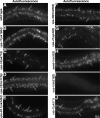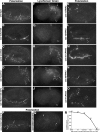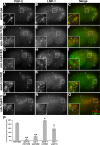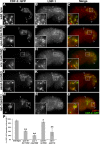Caenorhabditis elegans HOPS and CCZ-1 mediate trafficking to lysosome-related organelles independently of RAB-7 and SAND-1
- PMID: 24501423
- PMCID: PMC3967972
- DOI: 10.1091/mbc.E13-09-0521
Caenorhabditis elegans HOPS and CCZ-1 mediate trafficking to lysosome-related organelles independently of RAB-7 and SAND-1
Abstract
As early endosomes mature, the SAND-1/CCZ-1 complex acts as a guanine nucleotide exchange factor (GEF) for RAB-7 to promote the activity of its effector, HOPS, which facilitates late endosome-lysosome fusion and the consumption of AP-3-containing vesicles. We show that CCZ-1 and the HOPS complex are essential for the biogenesis of gut granules, cell type-specific, lysosome-related organelles (LROs) that coexist with conventional lysosomes in Caenorhabditis elegans intestinal cells. The HOPS subunit VPS-18 promotes the trafficking of gut granule proteins away from lysosomes and functions downstream of or in parallel to the AP-3 adaptor. CCZ-1 also acts independently of AP-3, and ccz-1 mutants mistraffic gut granule proteins. Our results indicate that SAND-1 does not participate in the formation of gut granules. In the absence of RAB-7 activity, gut granules are generated; however, their size and protein composition are subtly altered. These observations suggest that CCZ-1 acts in partnership with a protein other than SAND-1 as a GEF for an alternate Rab to promote gut granule biogenesis. Point mutations in GLO-1, a Rab32/38-related protein, predicted to increase spontaneous guanine nucleotide exchange, specifically suppress the loss of gut granules by ccz-1 and glo-3 mutants. GLO-3 is known to be required for gut granule formation and has homology to SAND-1/Mon1-related proteins, suggesting that CCZ-1 functions with GLO-3 upstream of the GLO-1 Rab, possibly as a GLO-1 GEF. These results support LRO formation occurring via processes similar to conventional lysosome biogenesis, albeit with key molecular differences.
Figures









Similar articles
-
Function and regulation of the Caenorhabditis elegans Rab32 family member GLO-1 in lysosome-related organelle biogenesis.PLoS Genet. 2018 Nov 12;14(11):e1007772. doi: 10.1371/journal.pgen.1007772. eCollection 2018 Nov. PLoS Genet. 2018. PMID: 30419011 Free PMC article.
-
An ABCG Transporter Functions in Rab Localization and Lysosome-Related Organelle Biogenesis in Caenorhabditis elegans.Genetics. 2020 Feb;214(2):419-445. doi: 10.1534/genetics.119.302900. Epub 2019 Dec 17. Genetics. 2020. PMID: 31848222 Free PMC article.
-
Genetic analysis of lysosomal trafficking in Caenorhabditis elegans.Mol Biol Cell. 2005 Jul;16(7):3273-88. doi: 10.1091/mbc.e05-01-0060. Epub 2005 Apr 20. Mol Biol Cell. 2005. PMID: 15843430 Free PMC article.
-
Cell type-specific Rab32 and Rab38 cooperate with the ubiquitous lysosome biogenesis machinery to synthesize specialized lysosome-related organelles.Small GTPases. 2013 Jan-Mar;4(1):16-21. doi: 10.4161/sgtp.22349. Epub 2012 Dec 17. Small GTPases. 2013. PMID: 23247405 Free PMC article. Review.
-
Molecular insights into endolysosomal microcompartment formation and maintenance.Biol Chem. 2022 Dec 13;404(5):441-454. doi: 10.1515/hsz-2022-0294. Print 2023 Apr 25. Biol Chem. 2022. PMID: 36503831 Review.
Cited by
-
Lysosome-related organelles promote stress and immune responses in C. elegans.Commun Biol. 2023 Sep 13;6(1):936. doi: 10.1038/s42003-023-05246-7. Commun Biol. 2023. PMID: 37704756 Free PMC article.
-
WAVE facilitates polarized E-cadherin transport.Mol Biol Cell. 2023 May 1;34(5):ar44. doi: 10.1091/mbc.E22-08-0322. Epub 2023 Mar 22. Mol Biol Cell. 2023. PMID: 36947190 Free PMC article.
-
LYSMD proteins promote activation of Rab32-family GTPases for lysosome-related organelle biogenesis.J Cell Biol. 2024 Oct 7;223(10):e202402016. doi: 10.1083/jcb.202402016. Epub 2024 Jul 30. J Cell Biol. 2024. PMID: 39078368 Free PMC article.
-
Cryosectioning and immunofluorescence of C. elegans reveals endogenous polyphosphate in intestinal endo-lysosomal organelles.Cell Rep Methods. 2024 Oct 21;4(10):100879. doi: 10.1016/j.crmeth.2024.100879. Epub 2024 Oct 15. Cell Rep Methods. 2024. PMID: 39413779 Free PMC article.
-
Characterization of HAF-4- and HAF-9-localizing organelles as distinct organelles in Caenorhabditis elegans intestinal cells.BMC Cell Biol. 2016 Jan 27;17:4. doi: 10.1186/s12860-015-0076-2. BMC Cell Biol. 2016. PMID: 26817689 Free PMC article.
References
-
- Aoyama M, Sun-Wada GH, Yamamoto A, Yamamoto M, Hamada H, Wada Y. Spatial restriction of bone morphogenetic protein signaling in mouse gastrula through the mVam2-dependent endocytic pathway. Dev Cell. 2012;22:1163–1175. - PubMed
Publication types
MeSH terms
Substances
Grants and funding
LinkOut - more resources
Full Text Sources
Other Literature Sources
Molecular Biology Databases
Research Materials
Miscellaneous

